Hip Pain After Running
It sucks to have hip pain running. While all of your friends are out running, you are stuck at home! Well, sleeping in isn’t too bad, but it’s going to get old fast.
I once had a hip injury that kept me from training with my team.
My injury kept me out for three months. After I recovered, I learned that I could have easily cut that time down by four weeks.
How?
Rehabbing it easy and often-and I’m not talking about rest and ice.
Through my hip injury, I began to learn more about how to treat and rehab them.
This article is my opportunity to give back to the running community. Read through as I have included information on the more common hip injuries we can get as runners.
- Hip Flexor Tendonitis
- Hip Impingement or Labral Tear
- Adductor Strain
- High Hamstring Strain
- Glute Medius Strain
- Trochanteric Bursitis
- Piriformis Syndrome
HIP PAIN RUNNING REASON #1:
HIP FLEXOR TENDONITIS
- Pain in the front of your hip when lifting your knee?
- Hurts when you step into the car?
- Gets worse after doing core exercises with your legs?
- Hip pain running?
Hip Flexor Tendonitis is a prevalent condition that can plague runners, mainly those of the distance variety.
If you run ½ marathons or further, you are at high risk of Hip Flexor Tendonitis. You don’t have to run in pain anymore.
Rehab for Hip Flexor Tendonitis is highly successful when done correctly. I, personally, have not had this injury, but I have managed many cases of it over the years.
Funny, one of my most popular videos still to this day is on “Stretching the Psoas.”
I have learned a lot more since making that video back in 2009.
I’ll share it in this video and the article below.
16 Hip Flexor Tendonitis Stretches, Exercises Treatments, & Assessments
Part 1 of 5 Series
What is Hip Flexor Tendonitis?
Tendonitis is irritation to a tendon. It can be chronic (long term) or acute (new injury). The primary hip flexor is the iliopsoas. The what, you say? The iliopsoas! You have probably heard of it called the psoas, but it is two muscles and one tendon. The tendon could be your problem.
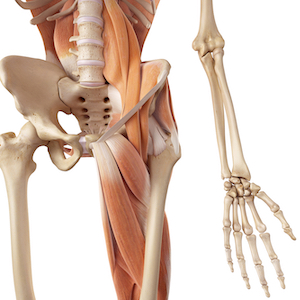
What causes Hip Flexor Tendonitis?
Hip Flexor Tendonitis happens when the hip flexors become dominant in the running gait. You’re probably thinking, how can this happen, right? Do some floor core exercises, and you’ll probably find your hip flexor can get super tight super fast. Muscles have what is called a healthy “length/tension relationship.” They want to be a certain length so they can work well. If your core is not holding your pelvis in an optimal position, then your hip flexor length will change. Think about being at work. I’m sure you have optimal working conditions.
- Not too cold, but not too hot.
- Not too many emails.
- Not too much background noise.
Muscles need an optimal environment to prevent breakdown. Having proper core strength and the ability to hold the pelvis in the correct position when running will decrease the probability of having downtime from this injury.

Hip Flexor Tendonitis Rehab/ Therapy?
As you can guess, to rehab Hip Flexor Tendonitis correctly, we need to create the optimal environment. This environment is not hard to design, but it is a lot of work on your part. Rehab exercise progression usually includes one that goes from easy to challenging. Before making things more challenging on the muscles, we always teach proper pelvis and trunk position. It is often a mental game that is frustrating to runners, but it is one that’s very teachable.
Here is a theory of progression that we often use in cases of Hip Flexor Tendonitis:
- Open chain exercise to closed chain exercise
- Lightweight to heavyweight
- Complete rest to incomplete rest
What does rest have to do with it? Running form, lifting form, posture, you name it. It all breaks down as you become out of breath. So we need to teach you how to have control of it. The Lewit Exercise is a great starting point for a core program. We always teach breathing and bracing before we start any core program. This exercise is enormously challenging for most people.
Here are some hip mobility drills I created for my patients with low back, hip, or knee conditions. Hip mobility is essential, and if you don’t have it, you can expect a cascade of injuries to come. I don’t want to be the bearer of bad news. Still, I have met many people with more advanced, painful conditions that started with hip dysfunction: sciatica, disc herniations, knee meniscus tears, and osteoarthritis. Spend 10 mins and go through this video.
Hip Flexor Tendonitis Treatment Options?
Here are some other treatments that can assist you in recovering from Hip Flexor Tendonitis:
- Active Release Technique
- Deep tissue massage
- Anti-inflammatory injections
- Prolotherapy
- Chiropractic adjustments or mobilizations
- Strength training/rehab/ core endurance
- PRICE therapy
- Running gait training
My favorite is strength and core training. Combined they seem to create the fastest and most lasting results. Soft tissue care, injections, massage and adjustments are useful but not lasting, since they don’t train the body how to take pressure off the hip flexor long-term.
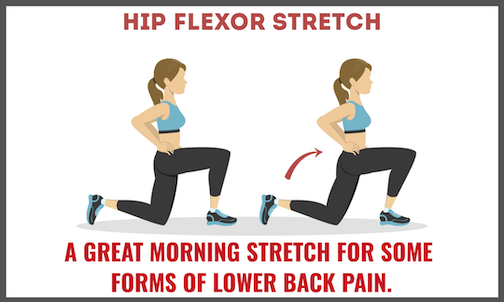
HIP PAIN RUNNING REASON #2:
HIP IMPINGEMENT & LABRAL TEAR
- Groin pain?
- Pinching in the front of the hip?
- Travels to the adductors area?
- May travel to the inner knee, but not past it?
- Deep ache in the side of the hip joint?
Hip impingement (AKA FAI) is something commonly found in runners, and sadly in past years, many of these cases fail conservative therapy. As of the last five years, experienced sports chiropractors and physical therapists have been able to help more athletes reduce groin pain with exercise focused therapy.
In many cases of hip impingement, specific corrective exercises are the cornerstone of recovery, with a sprinkle of manual therapy. Rarely is surgery required if the right treatment plan is applied and completed.
Hip impingement can progress into a hip labral tear, if not addressed quickly.
As a side note, change of skin sensations indicate there’s a nerve compression or tension aspect to your groin pain. It is not 100% joint or muscle-based.
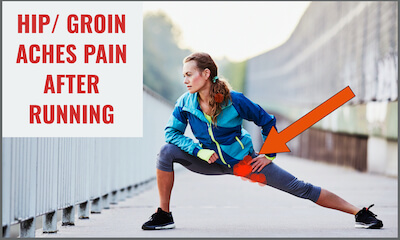
What is Hip Impingement?
Hip impingement is a pinch point in your hip. It seems like too simple an answer, and I know you want a little more information, but first, it is essential to understand what a pinch point is.
Hip impingement occurs in the same region of the hip flexor syndrome, so how can you tell if it is one or the other?
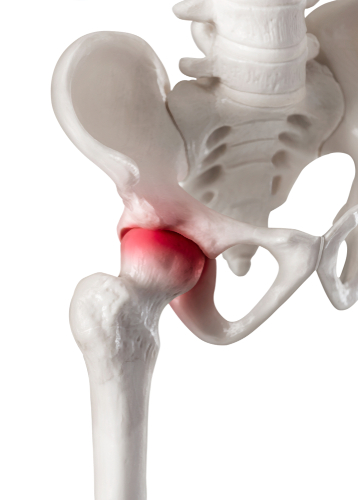
The easiest way is by describing how it feels.
If you bring your knee to your chest (via your arms) when lying on your back and there is a pinch, then I would suspect hip impingement. This simple test takes the hip flexor out of the mix because it does not use it.
Your arms pulled your leg up, right?
A pinch point is like slamming your hand in a car door over and over. No matter how many times you attempt to open and close the door, it does nothing to move your hand from the path of the door.
Damage to your hand will inevitably increase, correct?
The same thing happens in Hip Impingement. The structure caught in the “door” gets damaged every time you stretch it which could be a reason why you’re having hip pain running.
What causes Hip Impingement?
Hip Impingement occurs as pelvic, and hip mechanics change.
Let’s go back to that car door analogy:
Slowly, your hand inches closer and closer to the door, and finally, it’s close enough to be smashed.
Strength and motion coordination of the core and pelvic muscles usually are what will “move” your hand closer to the door or keep it from being smashed.
Note: the door didn’t move; it stayed where it always was.
Theoretically, the hip is supposed to operate in the same way.
Some issues can occur in the hip just as with the door. The hinges or the door jam could be falling off. For cases like these, we need to rehab the hip joint properly as well.
Your pelvic position is also an important factor in the reduction of hip impingement. A bony obstruction contacts the roof of the acetabulum and the femur in deep hip flexion.
One way to “raise the roof” of the acetabulum (pelvis) is to allow a posterior pelvic tilt; also known as “butt wink” in the fitness world. A posterior tilt occurs as we run out of hip flexion.
It is not advised to allow a posterior pelvic tilt when weightlifting, but in body weight motions it is fine, and advised for general health.

Hip Impingement Treatment Options
Here are some other treatments that can assist you in recovering from Hip Impingement:
- Active Release Technique
- Deep tissue massage
- Anti-inflammatory injections
- Prolotherapy
- Chiropractic adjustments or mobilizations
- Strength training/ rehab
- PRICE therapy
- Running gait training
I’d strongly suggest doing the strength training/ rehab rout. It works very well when you have a good doctor. At Performance Place®, we have near full reduction in most cases within under 3 weeks when using our methods.

HIP PAIN RUNNING REASON #3:
ADDUCTOR STRAIN
- Groin pain?
- Did you feel a pop when it happened?
- Can’t raise your leg?
- Hip pain running?
The adductor group of muscles is complex. Dare I say it- the adductor group is the most critical category of muscles of the hip for an athlete.
They do it all!
They flex the hip, they extend the hip, and they can even rotate it!
They are a sexy group of muscles; able to do all of these functions, and that is why when you injure one of them, it is an absolute must to rehab it.
Read this article and learn more about how we rehab and treat adductor injuries which could be a reason why you’re having hip pain running.
What is an Adductor Strain?
An Adductor Strain is a strain to the adductor muscle or tendon. Too simple?
Ok. The adductor is only one muscle from a collection of muscles from the hip. Most commonly, as a runner, you will have a strain of the adductor longus or adductor magnus.
What is a strain? A strain is a low-grade muscle tear. A Grade I tear to be exact.
Treat it as a tear. If you do not know how to treat a tear, we have one of the best articles on the rehab timeline of muscle tears on the web. You can access it here after you have finished this section.
What causes an Adductor Strain?
An Adductor Strain can be caused by overuse or over demand. Overuse is making a muscle do more than it physically can if it is in normal health, and biomechanics are perfect.
An analogy for over demand is this:
Remember the old martial arts movies?
Usually, someone punches through a plank of wood, right? There was nothing wrong with this wood (if used as wood is usually), but in this case, it got punched. Notice they never punched the wood from the top down. That’s because the wood plank is stronger that way.
In over demand cases, the muscle is not being allowed to be in its most strong state, and it breaks as a result.

Adductor Strain Rehab
Rehab of an Adductor Strain is a little different than that of other hip injuries. Since it is a low-grade tear, it needs more TLC in the form of deep tissue work before exercise rehab.
Weeks 1-3 are a great time for deep tissue work to help keep the scar tissue at the proper length.
Week 2 and onward are a great time to incorporate some adductor specific rehab. Training the core and pelvic muscles is important from week 0 until you are feeling better. Here is a self-help muscle work treatment that has worked well for our clients.
It is a lacrosse ball rolling on the adductor. This treatment is for the high adductor on the backside; if you have a different region of pain than indicated on the video, you may need to get something more for your condition. (NEW VIDEO COMING SOON… I DON’T LOVE THIS ONE BUT ITS THE BEST ONE I CAN FIND CURRENTLY)
Adductor Strain Treatment Options
Here are some other treatments that can assist you in recovering from an Adductor Strain:
- Active Release Technique
- Deep tissue massage
- Anti-inflammatory injections
- Prolotherapy
- Chiropractic adjustments or mobilizations
- Strength training/rehab
- PRICE therapy
- Running gait training
Just like many of the other groin pain diagnosis, strength training, and endurance core work tend to have the fastest and longest-lasting effect for active people. For non-active people, many of the passive therapies are good enough, such as massage, Active Release and joint mobilizations.
Adductor strain treatment has become an enigma for many rehab facilities. 6 weeks of therapy often reap low patient satisfaction. At our facility, we are pretty good at them (not to boast, just being honest). At the time of writing this article, we have had a 3-year span of not needing to send a single groin pain case to surgery. Come see us if you are struggling to recover. We are in Huntington Beach, CA.
HIP PAIN RUNNING REASON #4:
HIGH HAMSTRING STRAIN
- Painful to sit down?
- Does it hurt on the “sit bone?”
- Painful to run, but often loosens up after 15 minutes?
- Hip pain running?
These are signs of a possible high hamstring injury.
Hamstring injuries will limit the distance and speed you can run for months if you do not take the proper rehab approach.
The great news is rehab on this type of injury has been studied extensively and is very well understood. Now, the only thing standing between you and your running happiness is you. Read on to get the facts about high hamstring rehab.
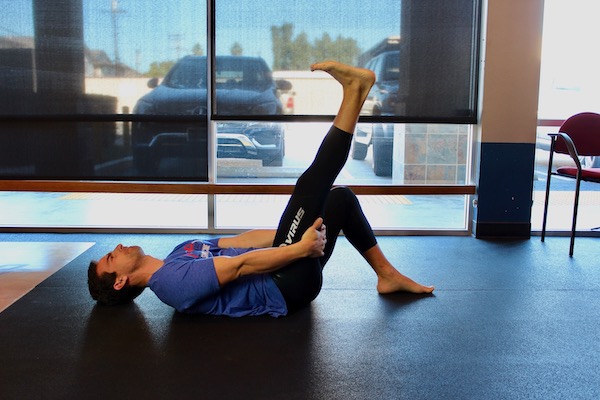
What is a High Hamstring Strain?
If you read about the Adductor Strain, you will understand a High Hamstring Strain better.
It is the same thing but in a different muscle and tendon.
Let’s recap.
The hamstrings are on the backside of the thigh and start at the gluteal crease. This insertion into the “sit bone” is a prevalent site of injury with runners. Also known as High Hamstring Tendonopathy, this type of hamstring injury can take months to heal and can be extremely frustrating for all kinds of athletes.
What causes a High Hamstring Strain?
High Hamstring Strains happen the same way any other strain of the hip and leg is-overuse, trauma, or over demand of the tissue.
If you want more on this, scroll back to the Adductor Strain section.
Hamstring injuries do have one thing unique about them, though. They are predictable in the fact that they become more probable the faster you run. Striders are a good example. I have had many runners come in saying their injuries begin after doing striders. I have nothing against striders, but the quick speed and broader range of motion are factors in hamstring injuries.
There are many other possible factors, but these are just a few you should know.
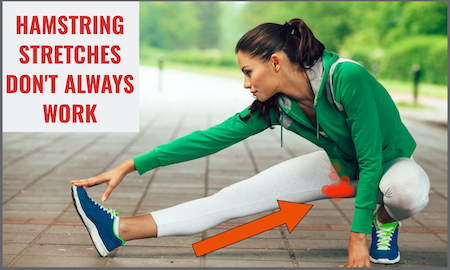
High Hamstring Strain Rehab
Hamstring Strain rehab programs are much better than they use to be, BUT it is essential to understand the type of injury that a “hammy” strain is.
Hamstring injuries are highly temperamental. They will flare up during rehab and reintroduction to running, so don’t get frustrated. Frustration and stopping a rehab program is the number one reason I have seen that causes runners to fail to recover.
We recommend the following exercise categories for our rehab programs.
- Multidirectional trunk stabilization
- Complex motions both unloaded and loaded
- Local eccentric exercises
- Hip mobility
- Change of direction drills
- Plyometrics
- Sprinting form instruction
One exercise you could have read about is the Nordic Hamstring Exercise. I have used it in many rehab programs, but I caution everyone about how intense these can be.
If you do it too early, you will hurt yourself. If you do too many reps and sets, you will hurt yourself. Here is our video on the Nordic Hamstring Exercise:
We also eventually need to challenge the hamstring in a lengthening hip hinge pattern. First unweighted and then weighted. Lastly, we would increase the speed. Romanian Deadlifts are a great way to learn hip hinge movements. This video should show you everything you need to know.
High Hamstring Strain Treatment Options
Here are some other treatments that can assist you in recovering from a Hamstring Strain:
- Active Release Technique
- Deep tissue massage
- Anti-inflammatory injections
- Prolotherapy
- Chiropractic adjustments or mobilizations
- Strength training/rehab
- PRICE therapy
- Running gait training
It’s critical to rule out the possibility of lumbar disc referred pain or referred pain from an S1 lumbar nerve root. This is simple to do with a skilled clinician, yet often overlooked before starting care. If you have not found help with a traditional hamstring strain rehab program, you could be suffering from one of the aforementioned conditions. They are simple to address but the starting point changes. Reach out to us for help.

HIP PAIN RUNNING REASON #5:
GLUTEUS MEDIUS STRAIN
- Pain on the side of your hip while sleeping?
- Better when you roll off of it?
- Deep ache on the side of the hip?
I would estimate a Gluteus Medius Strain as being in the top five most common injuries that could create hip pain running.
It is a simple injury to rehab and frequently does not need medication or injections. Read through this section and learn how we treat and rehab a Gluteus Medius Strain.

What is a Gluteus Medius Strain?
If you have been blowing through this whole article, you have already read about Adductor and Hamstring Strains. Glute Medius Strains are the same but in a new area.
Interestingly, Glute Medius Strains are misdiagnosed commonly as Trochanteric Bursitis. Sometimes called “Hip Bursitis,” this condition is an injury to the glute medius tendon where it inserts on the femur.
Around the femur is a natural fluid-filled sac called a bursa. The bursa can become inflamed, but this is usually because the adjacent glute medius tendon has damage. The bursa is not the issue. It is the tendon.
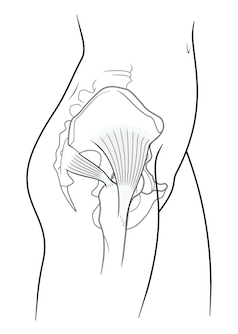
What causes a Gluteus Medius Strain?
A Glute Medius Strain is often primarily caused by poor function of the core and pelvis. How can this be? The glute medius is a lateral stabilizer of the hip joint.
What is lateral motion?
Think about when you stand with most of your weight on one leg than you shift it to the other. Your hip juts out to the side, correct? This movement challenges the glute medius of the loaded hip. With running, excessive lateral motion can challenge the glute medius over and over again, leading to damage. To rehab it, we need to tighten those motions up.
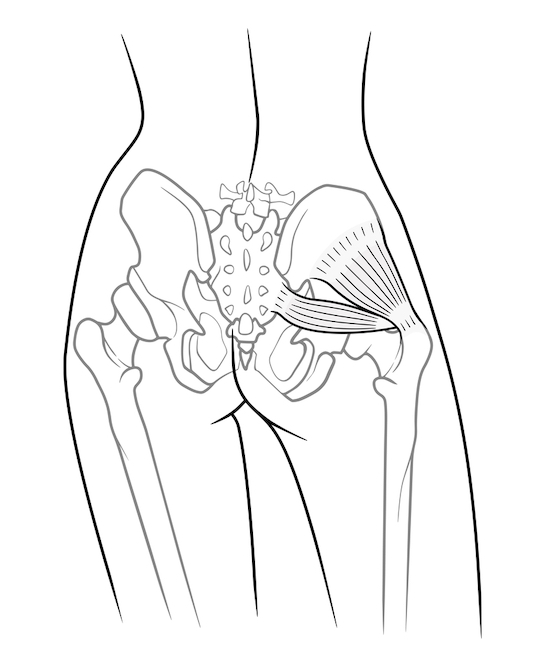
Gluteus Medius Strain Rehab
Just as with the other hip injuries, the core and pelvis are huge components. If you want to know more, scroll up, and read the rehab sections prior. The only significant difference is we emphasize lateral motion in a closed chain progression of exercises. An example is Lateral Band Walks.
With injuries of the hip, we also need to improve the rigidity of the trunk/ abdominal area. There are many ways to do this. One of the first ten exercises I give is a Front Plank. Here’s a quick example if you don’t know what one is.
We often work on closed chain hip rotational motions within the program too. If you’re lost now, that is not my intention. We often have clients who get confused about their rehab in the beginning. Still, after they start to do it all, they understand completely. If you want to learn more about how we rehab Glute Medius Tendon Strains, just check out our courses HERE.
Glute Medius Strain Treatment Options
Here are some other treatments that can assist you in recovering from a Glute Medius Strain:
- Active Release Technique
- Neurodynamics
- Deep tissue massage
- Anti-inflammatory injections
- Prolotherapy
- Chiropractic adjustments or mobilizations
- Strength training/rehab
- PRICE therapy
- Running gait training
In my experience, many runners with outer hip pain (in the region of the glutes) have their pain due to minor nerve pressure. This means there is nothing wrong with their glute tendons or bursa. MRIs and X-rays will be negative. Rehabilitation will be slow.
When you treat it as a nerve problem from day 1, my observation is most people experience a radical improvement within less than 2 weeks. No soft tissue work, adjusting or injections are needed in these types of cases. The Neurodynamic approach tends to work well, or even general spinal mobility exercises.
HIP PAIN RUNNING REASON #6:
TROCHANTERIC BURSITIS
What is Trochanteric Bursitis?
The trochanteric bursa is a normally occurring structure in the lateral (outer) hip. It can become inflamed and painful. It is very commonly associated with a glute medius tendon injury. When this is the case, the tendon injury needs addressing.
The bursa can be irritated as a secondary issue. Because more often than not, Trochanteric Bursitis is from a glute medius tendon injury, I will not write any more about it.
Wonder why I am writing about it in the first place then? Because many runners believe they have it. I just wanted to get the word out on the current thought process surrounding the bursal irritation. I don’t want anyone to waste their time learning about this condition. Rehab is focused more on the glute medius tendon injury. Please see above for a full write up.
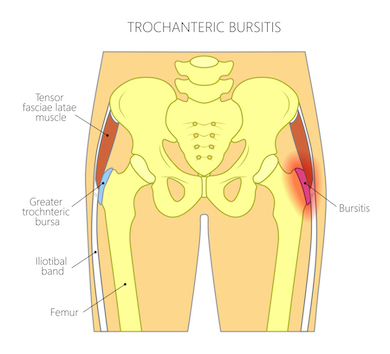
HIP PAIN RUNNING REASON #7:
PIRIFORMIS SYNDROME
- Stabbing pain in the glute area?
- Numbness on and off in the back of the thigh?
- Sometimes radiates to the foot?
- No lower back pain?
Together, these symptoms could indicate Piriformis Syndrome is your injury which could be a reason why you’re having hip pain running. But there is also the possibility that a back injury has created a radiculopathy or even sciatica. Only a proper exam can tell, so get to your sports doc for this one.
This injury is one of the few that will have you chasing pain. Nerve pain can travel a long distance. Treatment on the areas of referred pain will result in meager improvement rates. If you’d like to see what treatments work, I just created an updated case study article on one of our runners who overcame Piriformis Syndrome and ran again.
What is Piriformis Syndrome?
Piriformis Syndrome is a condition where a muscle (called the piriformis) tightens down on a nerve that passes under or through it (called the sciatic nerve). Because it is a nerve compression injury, the resulting distribution of the loss of sensation and pain can go all the way down to the foot.
Most of the time, people come in saying: “It hurts right here (points to the butt cheek), and it shoots down the back of my thigh, behind the knee, and to the bottom of the foot.” It can present in different variations if this pattern below the knee, but above it, the presentation is pretty standard.
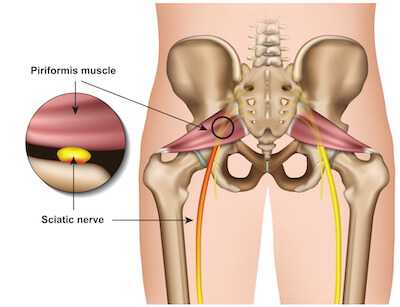
What causes Piriformis Syndrome?
Piriformis Syndrome is a direct result of hyper-tonicity (tightness) of the piriformis muscle.
What causes tightness in the first place is a different story.
Muscles of the hip can become tight from having to do more work than intended. Since the piriformis crosses the sacroiliac joint, it does assist in stabilizing it. If the joint is too loose, then the muscle is required to work in excess.
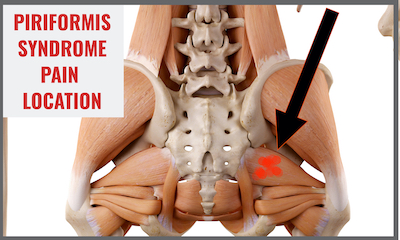
Piriformis Syndrome Rehab
I am going to sound like a broken record when I say this, but it is the truth. The keys are having a working core, pelvis, and running gait.
To have it all (and a bag of chips), you need these components:
- Multidirectional trunk stabilization
- Complex motions both unloaded and loaded
- Local stabilization exercises
- Hip mobility
- Change of direction drills
- Plyometrics
- Gait form instruction
Stop making your muscles work so hard, and they will stop getting pissed. Here is one exercise we use for local stabilization. This exercise had a very high EMG activity of the piriformis muscle in testing. It is called the Prone Heel Squeeze.
Piriformis Syndrome Treatment Options
Here are some treatments and therapies that can significantly assist in decreasing the symptoms of piriformis syndrome:
- Active Release Technique
- Neurodynamics
- Lumbar Disc Treatments
- Deep tissue massage
- Anti-inflammatory Injections
- Prolotherapy
- Chiropractic adjustments or mobilizations
- Strength training/rehab
- PRICE therapy
- Running gait training
Over the course of my 10 year in practice, I’ve only seen a few true cases of Piriformis Syndrome. On the other hand, I’ve seen 1000’s of cases of pain in the piriformis muscle. Over 90% of the time (in my observation), pain in the piriformis is simply referred pain from a lower back disc or a lower back pinched nerve.
Both respond very quickly to Neurodynamics and a Lumbar Disc protocol. Under the right guidance, you should expect a near 75% improvement within 2-3 weeks. Contact us if you are struggling to find this kind of result. We are in Huntington Beach CA.

